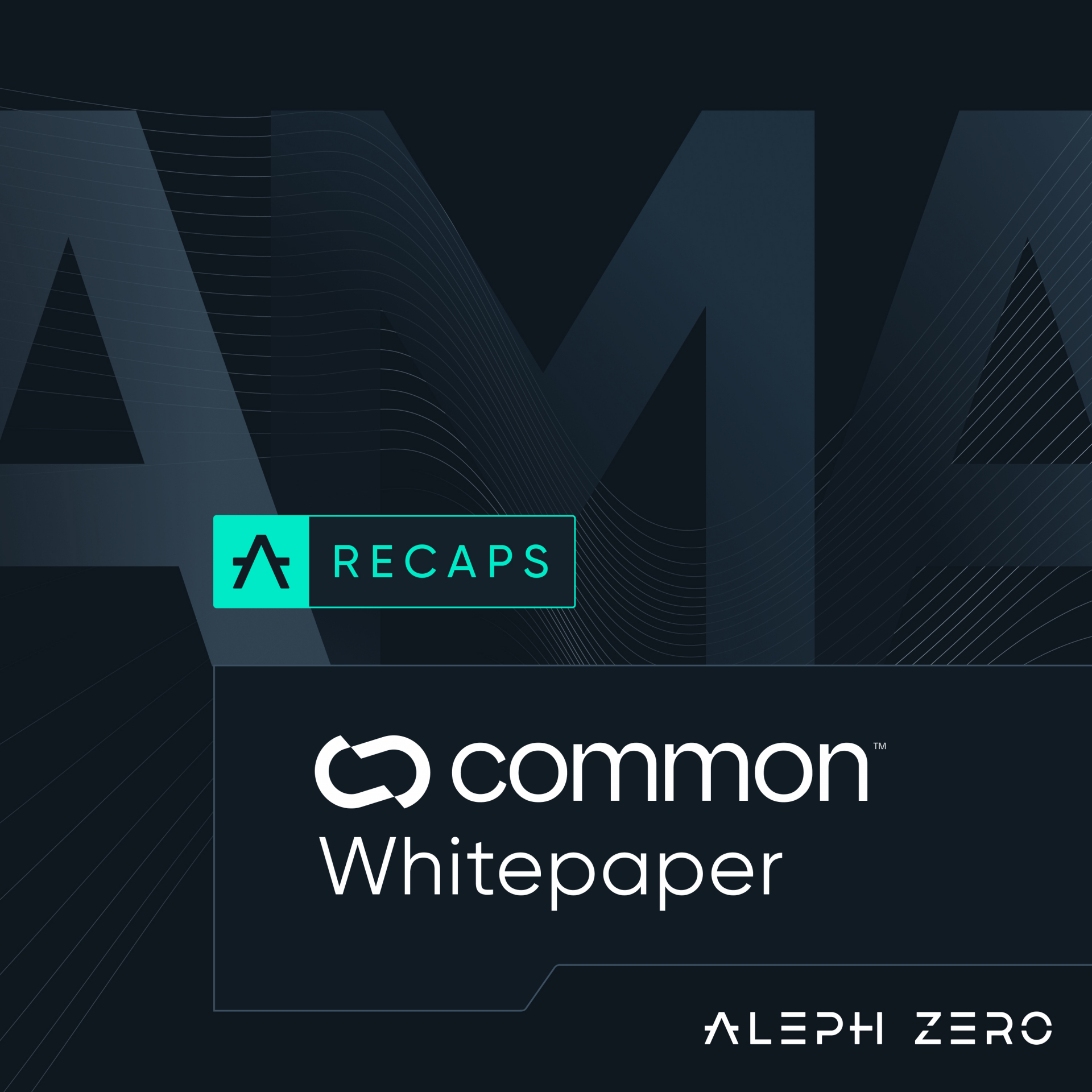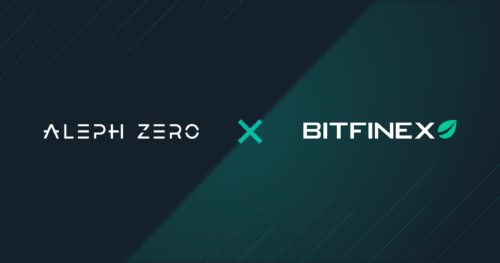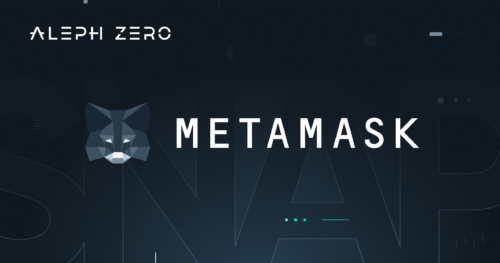Improving on DEXs and CEXs. The Key Takeaways from Common AMA.
Nov 21, 2023

The 17th episode of the Aleph Zero Podcast is the recap from the recent AMA covering key points about the Common Whitepaper by its authors—Adam Gągol, Damian Straszak, Aikaterini-Panagiota Stouka, and Albert Garreta. Read on to better understand what it does and what’s unique about it.
Listen to the episode on the platform of your choice
TL;DL
Too Long; Didn’t Listen
- Common is a unique proposition for the DEX market: it will offer access to on-chain privacy features, an innovative approach to liquidity aggregation, as well as a set of compliance-focused features to enhance the user experience. The privacy of user funds is ensured by employing shielded pools, batched transactions, and homomorphic encryption techniques.
- What differentiates it from other privacy-oriented DeFi products is the efficiency, economic modeling, and proactive approach to compliance with regulatory requirements.
- Common will be governed by a DAO with the authority to reveal the contents of shielded pools if there is a suspicion that funds have been procured through malicious activity.
- Users are more attracted to CEXs because they are easier to use and because the only party that knows users’ transactions is the central authority running the exchange. This is, in a way, more private than current DEXs, in which every transaction shows up on the blockchain for everyone to see.
- Common aims to change this by offering users the simplicity of a centralized exchange with the decentralization of a DEX with the added benefit of unique privacy features.
- Design choices have been made to ensure Common complies with GDPR and KYC/AML laws.
- Common will have its own token to incentivize liquidity providers and for governance.
- The DEX will be open-source, and the community can create its own trading pools and pairs.
Let’s dive into the questions asked during the AMA. First, general questions were asked to give the audience a general idea of the product.
What was the original idea behind working on Common?
Adam Gagol emphasized that Common’s development is based on blending strong privacy features with decentralization in DEXs. This approach is in response to the full transparency of existing blockchain exchanges that leave users’ transaction data exposed. By ensuring compliance with GDPR and AML/KYC regulations, Common is designed to protect user privacy.
In addition to privacy, Common addresses the need for improved price efficiency in the DeFi space, specifically targeting the reduction of MEV-related issues. It aims to prevent practices like frontrunning and sandwich attacks, which exploit user transactions, to promote fairer trading conditions.
How does Common address the identified challenges?
Privacy:
Common aims to guarantee not only the anonymity of users but also to hide the total funds being held by users at any given moment. This will be made possible by obscuring them in the so-called shielded pools. The trades will be batched together within certain price ranges and encrypted through homomorphic encryption to protect even such data as the trade size or the price of the orders.
The only thing that will be revealed is the aggregate of funds that users wish to trade. This list of trades will be decrypted and used as an order list in plaintext that will be internally matched through a smart contract. For the orders that won’t be fully matched within the internal process, they will be sold on a public Dutch auction.
Price efficiency:
The Dutch auction of Common will list the assets at initial prices and keep the auction live for a certain period of time. If the price is not met, the price will be lowered, and the process will continue until the assets are bought.
This system introduces efficient price discovery but can also offer extensive liquidity and, because of that, offers superior price efficiency. The Dutch auction’s mechanism is an incentive to bring liquidity from any external source–CEX or DEX–and trade against Common.
How compliant is Common?
Compliance with the privacy layer in Common is inherited from the design of Aleph Zero’s ZK- and sMPC-powered privacy engine.
Offering privacy to users makes the solution compliant with GDPR laws. On the other hand, there are AML laws that have to be addressed by the design. Because of that, to use shielded pools, users must claim a zero-knowledge identity to ensure traceability. However, the decision would be in the hands of a DAO, where users can vote to reveal the contents of the shielded pool if there’s a concern about certain funds’ origin. The system is also integrated with idOS and Coinfirm analytics platform that verifies accounts before they enter the private setting–in case there’s a threat of malicious activity, such users won’t be able to use shielded pools.
Where does the liquidity come from in Common?
Liquidity in Aleph Zero’s native DEX comes from both internal (i.e., through liquidity pools) and external sources, allowing users to take advantage of the liquidity circulating on other exchanges.
What’s so unique about the Dutch auction mechanism?
Dutch auction mechanisms allow the trade assets not matched within the initial internal matching phase. Thanks to that, if there’s not enough liquidity in the order book to complete a trade, the outstanding amount can be sold with the price efficiency of extended liquidity that has been brought to the venue by arbitrageurs. Dutch auctions simply make ‘intent-based execution’ practical.
What’s the development roadmap for Common?
One of the first things that the project wants to develop shortly is the Common Automatic Market Maker (AMM) as the initial DEX with liquidity coming from pools. Once the AMM is launched, more and more features will be rolled out gradually.
The team is also finalizing work on creating a safe and compliant ecosystem while incorporating the shielded pool with ZK-ID. The ZK-ID initial design will be proposed in the coming weeks as the core piece enabling a compliant use of on-chain privacy.
–
With these questions answered, the floor was opened for community questions. Here are the most interesting ones.
What is the plan for Common to provide privacy through mixing but not be put into the same basket as Tornado Cash and other mixing protocols related to all sorts of financial criminal activities?
In Common’s case, deposits from illicit activities will not be allowed to enter the shielded pool. To enter it, users must claim their ZK-ID while the DAO managing the shielded pool can vote for force revealing suspicious transactions.
How important will it be for Common to provide a seamless user experience, how important will it be for Common to provide educational tools or initiatives for platform users, and what steps are being taken for both user experience and education?
One of the key goals of Common is to introduce a seamless user experience similar to how CEXes operate while combining it with the custody and trustlessness of a DEX. However, it is still critical to ensure users of all levels can be onboarded easily to the platform–hence, extensive education and onboarding flows are designed to make using Common as easy as possible.
Where will the initial liquidity for AZERO/stable pairs come from? Will it draw from existing CEX listings, or will the AZF act as LP?
The initial liquidity will be a mix of assets from the AZF and the partner network participating in Common. Liquidity won’t be pulled out of CEXes for this matter.
However, the following liquidity will be sourced from users through incentives such as enabling them to use liquidity farms.
Could you give me additional details about the operation of the internal matching and Dutch auction mechanism within the SWAP-ENGINE of the Common DEX and explain their impact on enhancing trading conditions?
This matter is explained in detail in the Common Whitepaper itself.
Simply put, internal matching is trading against other users of the DEX, and the Dutch Auction is an open market for selling the remaining funds. The latter happens over a carefully chosen period of time, which incentivizes market makers to draw liquidity from other sources to make a profit on price differences.
Will Liminal and the ID tech be open source so other protocols can use the pools as long as they register to the ID system?
The code will be open source, and it will be possible to add trading pairs as non-core developers, which will be suitable for such use cases.
What is the functionality of the CMN token within the platform (if there is such a token)? Will it be used to reward LPs, for example?
The CMN tokenomics are not public yet. However, the general idea is to introduce the token to incentivize liquidity providers, such as in farming pools. There is also work on an economic mechanism in which the CMN token will be automatically bought off the market for internal use. It will also be used for the governance of Common.
How does Common address regulatory compliance and data privacy concerns (especially in regions with strict financial regulations) to ensure a seamless and secure experience for users?
The answer lies within the ZK-ID-based privacy, which will ensure that bad actors can be identified before entering the shielded pool or afterward, provided that the DAO governing the pool reaches an agreement over forced transaction reveal.
How complex will it be for arbitrageurs to jump into a Dutch auction (or see the various auctions available?)
The auctions will be tracked in regular smart contracts, so identifying the opportunities will be very easy. The mechanism will also stay permissionless to ensure arbitrageurs can apply various strategies.
Have any research/tests/simulations been made on how long the Dutch auction should last to allow arbitrage and not become a burden for the user having to wait for it to finish?
An upper bound on the auction duration is now treated as a parameter in the paper and needs to be determined. When the length of the Dutch auction reaches this upper bound, which means that the auction price is the worst price that the users are willing to accept, the auction stops even if there is still an amount untraded. Then, the users can collect the traded amount of their orders and leave the remaining untraded amount of their order to be traded in the next batches or claim it back. In practice, the length of the Dutch auction will also be based on the particular pair: on the popularity and liquidity of the market. It might also be dynamic based on the market conditions.”
Let’s say the SEC wants to get info about a transaction that has been made on the Common exchange. Would common give them more info than just the amount of tokens that have been traded?
When making a transaction on Common–or rather putting an order–nothing is visible except for the traded tokens and the price. It is unknown who is making the transaction or how much is in the order. Common, as a decentralized protocol does not give away more information than that.
Apart from that, the user who makes a particular transaction can–using viewing keys–reveal the details of its on-chain action to any particular auditor.
On top of that, the team is working on a deanonymization mechanism that would be directed towards bad actors–ones who have entered with funds from hacks, etc. This would enable uncovering the trace of such bad actors through the system, effectively making it impossible to launder or mix funds.
How long will it take for the Dutch auction phase? Will it be dynamic or static? What will be the step size of the increase in the price? Will it be a linear increase or dynamic? Lastly, as an end user, can I cancel my limit order during the Dutch auctioning phase?
The Dutch auction operates as explained in question 9. However, you can cancel your limit order at any time; although canceling means that it will not take part in any round in the future, you cannot remove it from the current round.
If your order is traded in the current round, it’s part of a larger batch; at this point, it’s impossible to cancel anymore.
–
Thank you for all the engagement throughout the AMA; we look forward to the next ones!
Listen podcast

EP. 17 Improving DEXs and CEXsu2014Common AMA Recap
The seventeenth episode of the Aleph Zero Podcast is a recap of a recent community Twitter space in which we met with Adam Gu0105gol and Damian Straszak of Aleph Zero and Aikaterini-Panagiota Stouka and Albert Garreta of Nethermind to answer questions on the Common DEX and decentralized finance.


